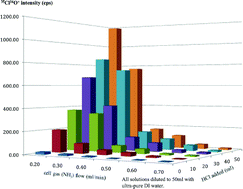A study was conducted to develop an accurate method for the determination of vanadium in environmental samples by inductively coupled plasma mass spectrometry (ICP-MS), coupled with a dynamic reaction cell (DRC), using two different chemical resolution strategies: (a) direct removal of interfering ClO+ and (b) vanadium oxidation to VO+. The performance of three reaction gases that are suitable for handling vanadium interference in the dynamic reaction cell was systematically studied and evaluated: ammonia for ClO+ removal and oxygen and nitrous oxide for oxidation. Although it was able to produce comparable results for vanadium to those using oxygen and nitrous oxide, NH3 did not completely eliminate a matrix effect, caused by the presence of chloride, and required large scale dilutions (and a concomitant increase in variance) when the sample and/or the digestion medium contained large amounts of chloride. Among the three candidate reaction gases at their optimized conditions, creation of VO+ with oxygen gas delivered the best analyte sensitivity and the lowest detection limit. Vanadium results obtained from fourteen lake sediment samples and a certified reference material (CRM031-040), using two different analyte/interference separation strategies, suggested that the vanadium mono-oxidation has advantages over the conventional method using NH3 for ultra-trace vanadium determination by ICP-DRC-MS and can be readily employed in relevant environmental chemistry applications.

You have access to this article
 Please wait while we load your content...
Something went wrong. Try again?
Please wait while we load your content...
Something went wrong. Try again?


 Please wait while we load your content...
Please wait while we load your content...